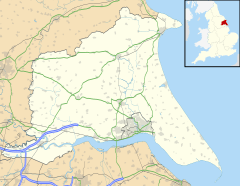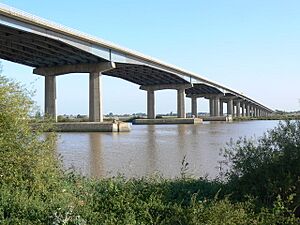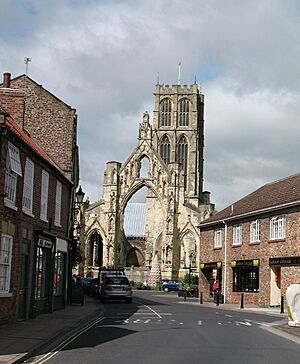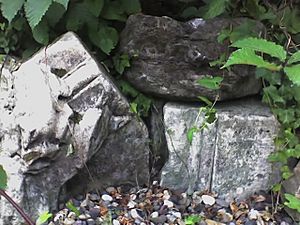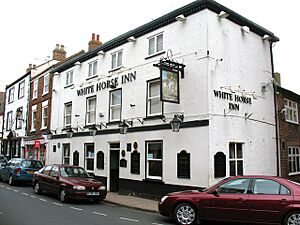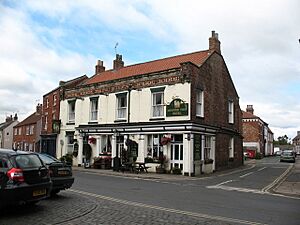Howden facts for kids
Quick facts for kids Howden |
|
|---|---|
 Howden Minster and Market Cross |
|
| Population | 4,142 (2011 Census) |
| OS grid reference | SE749281 |
| Civil parish |
|
| Unitary authority | |
| Ceremonial county | |
| Region | |
| Country | England |
| Sovereign state | United Kingdom |
| Post town | GOOLE |
| Postcode district | DN14 |
| Dialling code | 01430 |
| Police | Humberside |
| Fire | Humberside |
| Ambulance | Yorkshire |
| EU Parliament | Yorkshire and the Humber |
| UK Parliament |
|
Howden is a historic market town in the East Riding of Yorkshire, England. It's located in the Vale of York, not far from the M62. Howden is well-known for its impressive church, Howden Minster, which is one of the biggest churches in the East Riding area.
The town has a long history. In 1080, William the Conqueror gave Howden to the Bishops of Durham. For many years, the area around Howden, called Howdenshire, was actually part of County Durham.
Contents
Where is Howden Located?
Howden is found in the flat Vale of York. It's near the A614 road, though the main road now goes around the town. Howden is also close to the M62 motorway and M18 motorways.
The town is near Goole, which is on the other side of the River Ouse. Howden has its own train station in North Howden. From here, you can catch trains to cities like Leeds, York, and Hull.
The land around Howden is mostly flat. You'll see many drainage ditches, which help manage water in the area.
Howden's Early History
Howden has a rich past, with connections to English royalty. One of the first records shows King Edgar giving Howden Manor to his wife in 959 AD. This started a long link between Howden and the royal family.
In 1080, William the Conqueror gave the town and its church to the Bishop of Durham. The Bishop then gave the church to the monks of Durham. However, the Bishop kept Howden Manor for himself.
Howden's royal ties continued when Prince John visited in 1191. Nine years later, as King, John gave Howden the right to hold an annual fair. This fair became very important for the town.
Building Howden Minster
Work on the current Howden Minster began in 1228. It took a long time to finish, with parts like the chapter house and the top of the tower added in the 15th century.
In the 14th and 15th centuries, Howden became a popular place for pilgrims. This was because of stories about John of Howden and his alleged miracles in the late 1200s. People believed he could perform miracles.
One famous story says that at his funeral in 1275, John of Howden raised his arms from his coffin. Because of this, he was seen as a saint, even though the Catholic Church never officially made him one. The money brought by pilgrims helped complete the Minster.
Howden's Workhouse
From 1665 to 1794, a building in Howden was used to house people in need. Later, a workhouse was built there. This workhouse helped people who were poor or had no home. It had a factory, a stone-breaking yard, and even a small prison. In 1776, the workhouse could hold up to 20 people.
Later, in 1837, the Howden Poor Law Union was created. This group looked after the poor in Howden and many nearby villages. At first, they used existing workhouses. But in 1839, a new, bigger workhouse was built on Knedlington Road.
The Minster's Partial Ruin
In 1548, King Edward VI closed many churches, including Howden Minster. Later, Elizabeth I gave the Minster's income to local landowners. However, these landowners refused to fix the church's choir section. Because of this, the choir eventually fell into ruin.
The Minster suffered more damage during the English Civil War. Parliamentarian soldiers used it as a stable. They damaged the inside, breaking the organ and much of the wooden parts. It's said they even played the organ pipes like penny whistles when they left!
On September 29, 1696, the roof of the choir finally collapsed after almost 150 years of neglect. The fallen stones were left there until 1748. Then, the site was cleared, and local people took the stones to use for their own buildings.
Even though parts of it are ruined, the main part of Howden Minster (the nave) is still used today as the local parish church.
Howden in the 19th Century
In the early 1800s, Howden became famous across Europe for its huge horse fair. This fair was held every September. In Georgian times, it was called the "largest fair for horses in the Kingdom."
At its peak, the fair attracted horse dealers from all over the United Kingdom. It's believed that up to 4,000 horses were for sale each day. The total value of these sales could reach £200,000!
Even the British Army bought horses at the Howden fair. It's thought that Wellington's cavalry, famous from the Napoleonic Wars, rode horses bought right here in Howden.
Howden also has a long tradition of flower and garden shows. The Howden Floral and Horticultural Society started in 1854. Their first show was held in 1855. The shows stopped during the First World War and Second World Wars but have been held every year since. The 100th Howden Show was in 1979 and lasted two days. Today, the annual Howden Horticultural and Agricultural show is held on the first Sunday in July.
Most of Howden's buildings from this time are in the Georgian and Victorian styles. Many of the town's pubs were built then. People even say that Howden once had more pubs per square half-mile than anywhere else in the country!
One special building from this period is the Catholic Church of the Sacred Heart. It was designed by Joseph Aloysius Hansom, who also designed the famous hansom cab. The church opened in 1850 and is a beautiful example of his early work.
Howden got its first railway station in 1840. Another station, South Howden, was open from 1885 to 1955. In 1840, Howden was the site of a train accident where five passengers died. It was one of the first accidents investigated by the new Railway Inspectorate.
Howden in the 20th Century

During the First World War, the British Navy needed a place for a new airship station. This station would help protect ships from German U-boats. RNAS Howden opened in 1916 with huge airship hangars. It not only protected shipping but also created many jobs for local people. This helped Howden's economy, which had been struggling.
After the war, the airship station closed. But in 1924, it was bought by Vickers to build the airship R100. The famous author Nevil Shute Norway was part of the team that created the R100. He worked with Barnes Wallis, who later invented the bouncing bomb. Nevil Shute lived at 78 Hailgate in Howden, and there's a plaque on the house to remember him.
Nevil Shute wrote about his time in Howden in his book, Slide Rule: Autobiography of an Engineer. He described the local girls in a way that some people in Howden found upsetting.
In 1932, renovations on Howden Minster were finished. Its bells began chiming every 15 minutes, a tradition that continues today.
In the mid-20th century, Howden saw more changes. Two banks and two large Co-Op grocery stores opened. This made life more convenient for the people of Howden.
Howden in the 21st Century
In 2003, the Press Association (PA) opened its 'Operations Centre' in Howden. This building was opened by Prince Charles, continuing Howden's link with the Royal family.
PA employs hundreds of people in Howden. Many staff travel from other cities, which has put a strain on parking in the town. This led to new parking rules in the town centre.
The online retailer Ebuyer.com also moved its main offices to Howden. Their large warehouse and office are on Ferry Road. Next to Ebuyer.com is Wren Kitchens, which also has a new warehouse and distribution center.
There are plans for more development in Howden, including more homes and an industrial area.
Howden Minster is currently being renovated again with help from English Heritage. The Minster hopes to raise £300,000 for this work. The famous wood carver, Mousy Thompson, made the beautiful choir stalls and other furniture in the Minster. Kids love to search for the more than 30 tiny mice he carved and hid around the Minster!
In 2005, The Times newspaper listed Howden as one of the top 20 places in the UK with the best standard of living.
Notable People from Howden
- Henry Abbot (martyr) (died 1597)
- Bernard Kettlewell (1907–1979), a biologist
- Nevil Shute (1899–1960), an engineer and novelist
Media in Howden
You can get TV signals in Howden from the Emley Moor or Belmont TV transmitters. Local radio stations include BBC Radio Humberside and others. The local newspaper for the town is The Goole Times.
Howden's Governance
Howden has its own electoral ward. This ward includes areas west of Howden, like Barmby on the Marsh. In 2011, the total population of this ward was 4,865 people.
See also
 In Spanish: Howden para niños
In Spanish: Howden para niños


